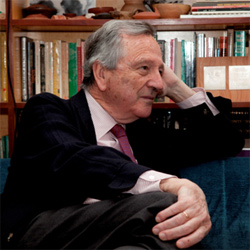 Museums, congress centers, town halls, railroad stations and even factories have been made more beautiful by Rafael Moneo, the renowned Spanish architect who, it has been said, "succeeds in creating a balance between tradition and innovation."
Museums, congress centers, town halls, railroad stations and even factories have been made more beautiful by Rafael Moneo, the renowned Spanish architect who, it has been said, "succeeds in creating a balance between tradition and innovation."
Moneo divides his professional life as an architect between teaching and practice. In both, he assumes a critical attitude toward the trend of short-lived architecture and seeks to emphasize the importance of buildings as enduring monuments to society.
"Architecture only reaches its true status when it is realized, when it acquires its being as an object, and when it is transformed into material reality as a building," he says.
Kim Tanzer, dean of U.Va.'s School of Architecture, said Moneo's legacy, as both a practitioner and an educator, cannot be overstated. "His ongoing life's work continues to inspire architects around the world," she said.
"Rafael Moneo's clear, persistent architectural vision – respectful of historic contexts, yet utterly of the present – first came to the attention of the international community as an antidote to the excesses of post-modern historicism," Tanzer said. "Later, as chair of the Harvard Graduate School of Design's Department of Architecture, he went on to provide leadership for several generations of architects and academics, grounding their studies in a thoughtful and poetic material sensibility."
José Rafael Moneo Vallés, 74, was born in Tudela, Spain. He obtained his architectural degree in 1961 from the School of Architecture in Madrid, then worked with Danish architect Jørn Utzon and studied at the Spanish Academy in Rome before opening his own practice in Madrid.
Among his best-known works in Spain are the Museum of Roman Art in Mérida, the Kursaal Congress Center in San Sebastian, the Pilar and Joan Miró Foundation in Palma de Mallorca and the Atocha Railway Station in Madrid.
His most prominent U.S. works include the Cathedral of Our Lady of the Angels in Los Angeles, the Audrey Jones Beck Building at the Houston Museum of Fine Arts, the Davis Art Museum at Wellesley College, and more recently the Laboratory for Integrated Science and Engineering at Harvard University, the Chace Center at the Rhode Island School of Design, and the Northwest Corner Building at Columbia University.
Works currently under construction include the Princeton University Neuroscience and Psychology Building and the Center for Contemporary Art de la Universidad de Navarra.
Moneo is also a noted theorist, critic and teacher. His scholarly work includes numerous and widely published articles and lectures. He has taught architecture at various sites around the world, and from 1985 to 1990 served as chair of the Harvard Graduate School of Design, where he is the first Josep Lluís Sert Professor of Architecture.
He was the first Spanish architect to be awarded the Pritzker Architecture Prize, often referred to as the profession's highest honor, in 1996. He is also the recipient of numerous additional awards, including the Gold Medal by the Spanish government, the Arnold W. Brunner Memorial Prize by the American Academy of Arts and Letters, the Prince of Viana Prize (Spain), the Swedish Schock Price for the Visual Arts and the Royal Institute of British Architects Gold Medal.
Moneo is an honorary fellow of the American Institute of Architects and the Royal Institute of British Architects.